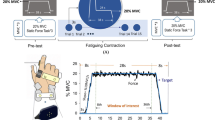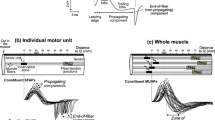Summary
Changes in the EMG power spectrum during static fatiguing contractions are often attributed to changes in muscle fibre action potential conduction velocity. Mathematical models of the EMG power spectrum, which have been empirically confirmed, predict that under certain conditions a distinct maximum occurs in the low-frequency part of the spectrum, indicating the dominant firing rate of the motor units. The present study investigated the influence of this firing rate peak on the spectral changes during a static fatiguing contraction at 50% of maximum EMG amplitude in the frontalis and corrugator supercilii muscles. An exponential decrease of the median frequency (MF) of the EMG power spectrum was observed when the firing rate peak was absent. When the firing rate peak was present, an exaggerated decrease of MF in the beginning of the contraction was found, which was associated with an increase in firing rate peak magnitude. In later stages of the contraction, a partial recovery of MF occurred, concomitant with a decrease in firing rate peak magnitude.
The influence of the firing rate peak on MF was also investigated during nonfatiguing contractions of the frontalis muscle at 20, 40, 60, and 80% of maximum EMG amplitude. A curvilinear relationship between MF and contraction strength was found, whether firing rate peaks were present or absent. The presence of firing rate peaks, however, was associated with a decrease in MF which was inversely related to contraction strength, due to the inverse relationship between firing rate peak magnitude and contraction strength.
Similar content being viewed by others
References
Bendat JS, Piersol AG (1971) Random data: analysis and measurement procedures. Wiley-Interscience, New York
Bigland-Ritchie B, Donovan EF, Roussos CS (1981) Conduction velocity and EMG power spectrum changes in fatigue of sustained maximal efforts. J Appl Physiol 51: 1300–1305
Blinowska A, Verroust J, Cannet G (1979) The determination of motor units characteristics from the low frequency electromyographic power spectra. Electromyogr Clin Neurophysiol 19: 281–290
Blinowska A, Verroust J, Cannet G (1980) An analysis of synchronization and double discharge effects on low frequency electromyographic power spectra. Electromyogr Clin Neurophysiol 20: 465–480
Christakos CN, Lal S (1980) Lumped and population stochastic models of skeletal muscle: implications and predictions. Biol Cybern 36: 73–85
De Luca CJ (1979) Physiology and mathematics of myoelectric signals. IEEE Trans Biomed Eng BME-26: 313–325
Elble RJ, Randall JE (1976) Motor-unit activity responsible for 8- to 12-Hz component of human physiological finger tremor. J Neurophysiol 39: 370–383
Freund H-J, Büdingen HJ, Dietz V (1975) Activity of single motor units from human forearm muscles during voluntary isometric contractions. J Neurophysiol 38: 933–946
Gydikov A, Kosarov D, Dimitrov GV (1979) Length of the summated depolarized area and duration of depolarizing and repolarizing processes in the motor unit under different conditions. Electromyogr Clin Neurophysiol 19: 229–248
Hagbarth K-E, Young RR (1979) Participation of the stretch reflex in human physiological tremor. Brain 102: 509–526
Hagberg M, Ericson B-E (1982) Myoelectric power spectrum dependence on muscular contraction level of elbow flexors. Eur J Appl Physiol 48: 147–156
HÄgg G (1981) Electromyographic fatigue analysis based on the number of zero crossings. Pfluegers Arch 391: 78–80
Hogan N, Mann RW (1980) Myoelectric signal processing: optimal estimation applied to electromyography. Part II: Experimental demonstration of optimal myoprocessor performance. IEEE Trans Biomed Eng BME-27: 396–410
Kadanoff D (1956) Die sensiblen Nervenendungen in der mimischen Muskulatur des Menschen. Z Mikrosk Anat Forsch 62: 1–15
Kanosue K, Yoshida M, Akazawa K, Fujii K (1979) The number of active motor units and their firing rates in voluntary contraction of human brachialis muscle. Jpn J Physiol 29: 427–443
Komi PV, Viitasalo JHT (1976) Signal characteristics of EMG at different levels of muscle tension. Acta Physiol Scand 96: 267–276
Lago P, Jones NB (1977) Effect of motor-unit firing time statistics on e.m.g. spectra. Med Biol Eng Comput 15: 648–655
Lago PJ, Jones NB (1981) Low-frequency spectral analysis of the EMG. Med Biol Eng Comput 19: 779–782
Lindström L, Kadefors R, Petersén I (1977) An electromyographic index for localized muscle fatigue. J Appl Physiol 43: 750–754
Lindström L, Magnusson R, Petersén I (1970) Muscular fatigue and action potential conduction velocity changes studied with frequency analysis of EMG signals. Electromyography 10: 341–356
Lynn PA (1979) Direct on-line estimation of muscle fiber conduction velocity by surface electromyography. IEEE Trans Biomed Eng BME-26: 564–571
Masuda T, Miyano H, Sadoyama T (1982) The measurement of muscle fiber conduction velocity using a gradient threshold zero-crossing method. IEEE Trans Biomed Eng BME-29: 673–678
Maton B (1981) Human motor unit activity during the onset of muscle fatigue in submaximal isometric isotonic contraction. Eur J Appl Physiol 46: 271–281
Monster AW, Chan H (1977) Isometric force production by motor units of extensor digitorum communis muscle in man. J Neurophysiol 40: 1432–1443
Mori S (1973) Discharge patterns of soleus motor units with associated changes in force exerted by foot during quiet stance in man. J Neurophysiol 36: 458–471
Naeije M, Zorn H (1982) Relation between EMG power spectrum shifts and muscle fibre action potential conduction velocity changes during local muscular fatigue in man. Eur J Appl Physiol 50: 23–33
Naeije M, Zorn H (1983) Estimation of the action potential conduction velocity in human skeletal muscle using the surface EMG cross-correlation technique. Electromyogr Clin Neurophysiol 23: 73–80
Palla S, Ash MM (1981) Effect of bite force on the power spectrum of the surface electroymogram of human jaw muscles. Arch Oral Biol 26: 287–295
Person RS, Kudina LP (1968) Cross-correlation of electromyograms showing interference patterns. Electroencephalogr Clin Neurophysiol 25: 58–68
Petrofsky JS (1980) Filter bank analyser for automatic analysis of the e.m.g. Med Biol Eng Comput 18: 585–590
Petrofsky JS, Lind AR (1980a) Frequency analysis of the surface electromyogram during sustained isometric contractions. Eur J Appl Physiol 43: 173–182
Petrofsky JS, Lind AR (1980b) The influence of temperature on the amplitude and frequency components of the EMG during brief and sustained isometric contractions. Eur J Appl Physiol 44: 189–200
Sadoyama T, Miyano H (1981) Frequency analysis of surface EMG to evaluation of muscle fatigue. Eur J Appl Physiol 47: 239–246
Stålberg E (1966) Propagation velocity in human muscle fibers in situ. Acta Physiol Scand 70 [Suppl] 287: 1–112
Stulen FB, De Luca CJ (1981) Frequency parameters of the myoelectric signal as a measure of muscle conduction velocity. IEEE Trans Biomed Eng BME-28: 515–523
Van Boxtel A, Goudswaard P, Van der Molen GM, Van den Bosch WEJ (1983) Changes in electromyogram power spectra of facial and jaw-elevator muscles during fatigue. J Appl Physiol 54: 51–58
Van Boxtel A, Schomaker LRB (1983) Motor unit firing rate during static contraction indicated by the surface EMG power spectrum. IEEE Trans Biomed Eng (in press)
Verroust J, Blinowska A, Cannet G (1981) Functioning of the ensemble of motor units of the muscle determined from global EMG signal. Electromyogr Clin Neurophysiol 21: 11–24
Viitasalo JHT, Komi PV (1977) Signal characteristics of EMG during fatigue. Eur J Appl Physiol 37: 111–121
Viitasalo JT, Komi PV (1978) Interrelationships of EMG signal characteristics at different levels of muscle tension and during fatigue. Electromyogr Clin Neurophysiol 18: 167–178
Vredenbregt J, Rau G (1973) Surface electromyography in relation to force, muscle length and endurance. In: Desmedt JE (ed) New developments in electromyography and clinical neurophysiology, vol 1. Karger, Basel, pp 607–622
Young RR, Hagbarth K-E (1980) Physiological tremor enhanced by manoeuvres affecting the segmental stretch reflex. J Neurol Neurosurg Psychiatry 43: 248–256
Author information
Authors and Affiliations
Rights and permissions
About this article
Cite this article
van Boxtel, A., Schomaker, L.R.B. Influence of motor unit firing statistics on the median frequency of the EMG power spectrum. Europ. J. Appl. Physiol. 52, 207–213 (1984). https://doi.org/10.1007/BF00433394
Accepted:
Issue Date:
DOI: https://doi.org/10.1007/BF00433394




